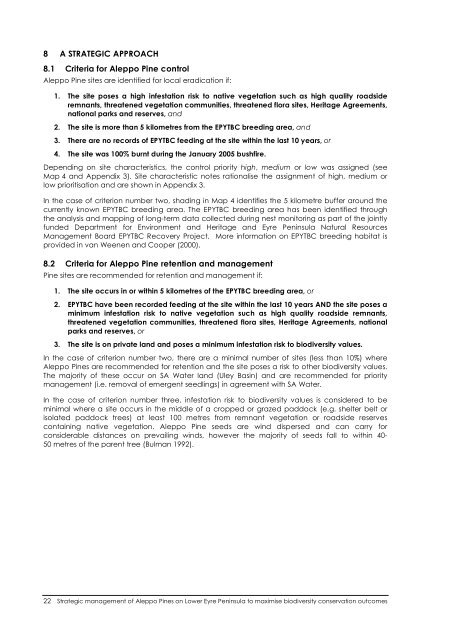Strategic management of Aleppo Pines on Lower Eyre
Strategic management of Aleppo Pines on Lower Eyre
Strategic management of Aleppo Pines on Lower Eyre
You also want an ePaper? Increase the reach of your titles
YUMPU automatically turns print PDFs into web optimized ePapers that Google loves.
8 A STRATEGIC APPROACH<br />
8.1 Criteria for <str<strong>on</strong>g>Aleppo</str<strong>on</strong>g> Pine c<strong>on</strong>trol<br />
<str<strong>on</strong>g>Aleppo</str<strong>on</strong>g> Pine sites are identified for local eradicati<strong>on</strong> if:<br />
1. The site poses a high infestati<strong>on</strong> risk to native vegetati<strong>on</strong> such as high quality roadside<br />
remnants, threatened vegetati<strong>on</strong> communities, threatened flora sites, Heritage Agreements,<br />
nati<strong>on</strong>al parks and reserves, and<br />
2. The site is more than 5 kilometres from the EPYTBC breeding area, and<br />
3. There are no records <str<strong>on</strong>g>of</str<strong>on</strong>g> EPYTBC feeding at the site within the last 10 years, or<br />
4. The site was 100% burnt during the January 2005 bushfire.<br />
Depending <strong>on</strong> site characteristics, the c<strong>on</strong>trol priority high, medium or low was assigned (see<br />
Map 4 and Appendix 3). Site characteristic notes rati<strong>on</strong>alise the assignment <str<strong>on</strong>g>of</str<strong>on</strong>g> high, medium or<br />
low prioritisati<strong>on</strong> and are shown in Appendix 3.<br />
In the case <str<strong>on</strong>g>of</str<strong>on</strong>g> criteri<strong>on</strong> number two, shading in Map 4 identifies the 5 kilometre buffer around the<br />
currently known EPYTBC breeding area. The EPYTBC breeding area has been identified through<br />
the analysis and mapping <str<strong>on</strong>g>of</str<strong>on</strong>g> l<strong>on</strong>g-term data collected during nest m<strong>on</strong>itoring as part <str<strong>on</strong>g>of</str<strong>on</strong>g> the jointly<br />
funded Department for Envir<strong>on</strong>ment and Heritage and <strong>Eyre</strong> Peninsula Natural Resources<br />
Management Board EPYTBC Recovery Project. More informati<strong>on</strong> <strong>on</strong> EPYTBC breeding habitat is<br />
provided in van Weenen and Cooper (2000).<br />
8.2 Criteria for <str<strong>on</strong>g>Aleppo</str<strong>on</strong>g> Pine retenti<strong>on</strong> and <str<strong>on</strong>g>management</str<strong>on</strong>g><br />
Pine sites are recommended for retenti<strong>on</strong> and <str<strong>on</strong>g>management</str<strong>on</strong>g> if:<br />
1. The site occurs in or within 5 kilometres <str<strong>on</strong>g>of</str<strong>on</strong>g> the EPYTBC breeding area, or<br />
2. EPYTBC have been recorded feeding at the site within the last 10 years AND the site poses a<br />
minimum infestati<strong>on</strong> risk to native vegetati<strong>on</strong> such as high quality roadside remnants,<br />
threatened vegetati<strong>on</strong> communities, threatened flora sites, Heritage Agreements, nati<strong>on</strong>al<br />
parks and reserves, or<br />
3. The site is <strong>on</strong> private land and poses a minimum infestati<strong>on</strong> risk to biodiversity values.<br />
In the case <str<strong>on</strong>g>of</str<strong>on</strong>g> criteri<strong>on</strong> number two, there are a minimal number <str<strong>on</strong>g>of</str<strong>on</strong>g> sites (less than 10%) where<br />
<str<strong>on</strong>g>Aleppo</str<strong>on</strong>g> <str<strong>on</strong>g>Pines</str<strong>on</strong>g> are recommended for retenti<strong>on</strong> and the site poses a risk to other biodiversity values.<br />
The majority <str<strong>on</strong>g>of</str<strong>on</strong>g> these occur <strong>on</strong> SA Water land (Uley Basin) and are recommended for priority<br />
<str<strong>on</strong>g>management</str<strong>on</strong>g> (i.e. removal <str<strong>on</strong>g>of</str<strong>on</strong>g> emergent seedlings) in agreement with SA Water.<br />
In the case <str<strong>on</strong>g>of</str<strong>on</strong>g> criteri<strong>on</strong> number three, infestati<strong>on</strong> risk to biodiversity values is c<strong>on</strong>sidered to be<br />
minimal where a site occurs in the middle <str<strong>on</strong>g>of</str<strong>on</strong>g> a cropped or grazed paddock (e.g. shelter belt or<br />
isolated paddock trees) at least 100 metres from remnant vegetati<strong>on</strong> or roadside reserves<br />
c<strong>on</strong>taining native vegetati<strong>on</strong>. <str<strong>on</strong>g>Aleppo</str<strong>on</strong>g> Pine seeds are wind dispersed and can carry for<br />
c<strong>on</strong>siderable distances <strong>on</strong> prevailing winds, however the majority <str<strong>on</strong>g>of</str<strong>on</strong>g> seeds fall to within 40-<br />
50 metres <str<strong>on</strong>g>of</str<strong>on</strong>g> the parent tree (Bulman 1992).<br />
22 <str<strong>on</strong>g>Strategic</str<strong>on</strong>g> <str<strong>on</strong>g>management</str<strong>on</strong>g> <str<strong>on</strong>g>of</str<strong>on</strong>g> <str<strong>on</strong>g>Aleppo</str<strong>on</strong>g> <str<strong>on</strong>g>Pines</str<strong>on</strong>g> <strong>on</strong> <strong>Lower</strong> <strong>Eyre</strong> Peninsula to maximise biodiversity c<strong>on</strong>servati<strong>on</strong> outcomes

















